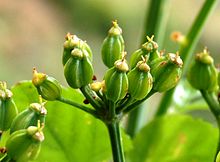Horse carpet
| Horse carpet | ||||||||||||
|---|---|---|---|---|---|---|---|---|---|---|---|---|

Horse Carpet ( Smyrnium olusatrum ) |
||||||||||||
| Systematics | ||||||||||||
|
||||||||||||
| Scientific name | ||||||||||||
| Smyrnium olusatrum | ||||||||||||
| L. |
The smyrnium olusatrum ( Smyrnium olusatrum ), also (Gespenst-) Yellow umbel or Alisander , Smyrnerkraut called, is a species of the genus yellow cones ( Smyrnium ) within the family of the Umbelliferae (Apiaceae).
description
Vegetative characteristics
The horse carpet grows as a biennial herbaceous plant and reaches heights of 50 to 150 cm, rarely up to 180 cm. The ribbed stems are bare and often hollow when old. The strong-smelling main root is thickened and extends 50 to 60 cm deep, thinner side roots run just below the surface of the earth.
The leaves are two- to three-fold pinnate or, more rarely, three-fold, in the upper part sometimes simple and stalk-encompassing to mixed, dark green, shiny and bare. In the upper area the petioles are partly with a leaf sheath . The individual pinna flake or leaves are ovate to lobed to round and pointed kerbig-sawed.
Generative characteristics
The plants are Andromonozoic . The long-stemmed and double-gold inflorescence contains male and hermaphrodite flowers in a ratio of about 4: 1. The shells and shells are mostly missing or small. The very small, greenish-yellow to yellow colored, five-fold flowers have a diameter of 1.5 mm. The calyx is missing or greatly reduced. The stylus pad is fleshy and conspicuous with short stylus branches.
The laterally somewhat flattened, broadly egg-shaped and blackish, glabrous cleft fruit with carpophor has a diameter of 7 to 8 mm. The ribbed and solitary partial fruits have some oil cells (vittae).
The number of chromosomes is 2n = 22.
Occurrence
The horse carpet originally comes from the Azores , Morocco, Algeria , Tunisia, Libya , Spain, Gibraltar , the Balearic Islands , Portugal, France, Monaco, Italy, Corsica , Sardinia , Sicily, Malta, Croatia , Montenegro , Albania, Greece, Crete , in the Aegean Sea, in Cyprus , in European and Asian Turkey, Syria , Lebanon, Jordan and Israel. In Ireland and Great Britain the species is a neophyte. The horse carpet grows in bushes and weed fields near the coast. This species is likely originally from the Mediterranean area , but is also found along the European Atlantic coast to Denmark , as well as on the British Isles , probably due to its use and distribution by humans. In Germany, the horse carpet occurs in companies of the Alliarion association.
use
The horse carpet is grown as a crop in southern Europe, North Africa and the Canary Islands. The roots, leaves and young shoots that smell of celery can be used as salad or vegetables. In the Middle Ages, the horse carpet was also used in Central Europe; it is mentioned in the Capitulare de villis vel curtis imperii , among others .
The seeds are used as a spice.
literature
- R. Fitter, A. Fitter, M. Blamey: Parey's flower book. 2nd edition, Parey, Hamburg / Berlin 1986, ISBN 3-490-22418-3 .
- RE Randall: Biological Flora of the British Isles. Smyrnium olusatrum L. In: Journal of Ecology . tape 91 , no. 2 , 2003, p. 325-340 , doi : 10.1046 / j.1365-2745.2003.00761.x .
- PN Ravindran: The Encyclopedia of Herbs and Spices. Vol. 1, CABI, 2017, ISBN 978-1-78639-114-8 , pp. 117 ff.
- Joachim W. Kadereit , Volker Bittrich: The Families and Genera of Vascular Plants. Vol.XV : Flowering Plants Eudicots , Springer, 2018, ISBN 978-3-319-93604-8 , pp. 15, 39, 43, 60, 189.
- Eduard Winkler : Complete Real Lexicon ... Second volume: M – Z , Brockhaus, 1842, p. 658.
Web links
- Smyrnium olusatrum at Useful Temperate Plants.
- Smyrnium olusatrum at Website of Arthur Lee Jacobson.
- Alexander's Smyrnium olusatrum at Wild Flower Finder.
- Horse carpet at the Freundeskreis Botanischer Garten Aachen e. V.
- Smyrnium olusatrum at Savvas Tryfonos Cyprus Plants Photography.
Individual evidence
- ↑ a b Erich Oberdorfer : Plant-sociological excursion flora for Germany and neighboring areas . With the collaboration of Angelika Schwabe and Theo Müller. 8th, heavily revised and expanded edition. Eugen Ulmer, Stuttgart (Hohenheim) 2001, ISBN 3-8001-3131-5 , pp. 705 .
- ↑ Smyrnium olusatrum at Tropicos.org. In: IPCN Chromosome Reports . Missouri Botanical Garden, St. Louis
- ↑ a b Ralf Hand (2011): Apiaceae. - In: Euro + Med Plantbase - the information resource for Euro-Mediterranean plant diversity. Datasheet Smyrnium
- ↑ A. Täufel, W. Ternes, L. Tunger, M. Zobel (eds.) Food Lexicon. Behr's Verlag, 2005, ISBN 3-89947-165-2 .



